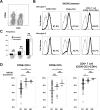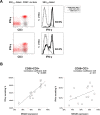Genotype-Associated Differential NKG2D Expression on CD56+CD3+ Lymphocytes Predicts Response to Pegylated-Interferon/Ribavirin Therapy in Chronic Hepatitis C
- PMID: 25965701
- PMCID: PMC4428701
- DOI: 10.1371/journal.pone.0125664
Genotype-Associated Differential NKG2D Expression on CD56+CD3+ Lymphocytes Predicts Response to Pegylated-Interferon/Ribavirin Therapy in Chronic Hepatitis C
Abstract
Hepatitis C virus (HCV) genotype 1 infections are significantly more difficult to eradicate with PEG-IFN/ribavirin therapy, compared to HCV genotype 2. The aim of this work is to investigate the difference of immunological impairments underlying this phenomenon. Pre-treatment NKG2D expression on peripheral CD56+CD3+ lymphocytes and CD56+CD3- NK cells from cases of chronic hepatitis C were analyzed and assessed by treatment effect. Two strains of HCV were used to co-incubate with immune cells in vitro. NKG2D expression on peripheral CD56+CD3+ lymphocytes, but not NK cells, was significantly impaired in genotype 1 infection, compared to genotype 2. When peripheral blood mononuclear cells from healthy donors were co-incubated with TNS2J1, a genotype 1b/2a chimera strain, or with JFH1, a genotype 2a strain, genotype-specific decrease of NKG2D on CD56+CD3+ lymphocytes, but not NK cells, was observed. Pre-treatment NKG2D expression on peripheral CD56+CD3+ lymphocytes significantly correlated with reduction in serum HCV RNA levels from week 0 to week 4, and predicted treatment response. Ex vivo stimulation of peripheral CD56+CD3+ lymphocytes showed NKG2D expression-correlated IFN-γ production. In conclusion, Decreased NKG2D expression on CD56+CD3+ lymphocytes in chronic HCV genotype 1 infection predicts inferior treatment response to PEG-IFN/ribavirin therapy compared to genotype 2.
Conflict of interest statement
Figures






Similar articles
-
Expansion of functionally skewed CD56-negative NK cells in chronic hepatitis C virus infection: correlation with outcome of pegylated IFN-alpha and ribavirin treatment.J Immunol. 2009 Nov 15;183(10):6612-8. doi: 10.4049/jimmunol.0901437. Epub 2009 Oct 21. J Immunol. 2009. PMID: 19846870
-
Lead-in treatment with interferon-β/ribavirin may modify the early hepatitis C virus dynamics in pegylated interferon alpha-2b/ribavirin combination for chronic hepatitis C patients with the IL28B minor genotype.J Gastroenterol Hepatol. 2013 Mar;28(3):443-9. doi: 10.1111/jgh.12039. J Gastroenterol Hepatol. 2013. PMID: 23173698 Clinical Trial.
-
Association of NKG2A with treatment for chronic hepatitis C virus infection.Clin Exp Immunol. 2010 Aug;161(2):306-14. doi: 10.1111/j.1365-2249.2010.04169.x. Epub 2010 Jun 9. Clin Exp Immunol. 2010. PMID: 20550548 Free PMC article.
-
Sustained virologic response and IL28B single-nucleotide polymorphisms in patients with chronic hepatitis C treated with pegylated interferon alfa and ribavirin.Acta Biochim Pol. 2012;59(3):333-7. Epub 2012 Aug 27. Acta Biochim Pol. 2012. PMID: 22924160
-
Interferon-λ3 polymorphisms in pegylated-interferon-α plus ribavirin therapy for genotype-2 chronic hepatitis C.World J Gastroenterol. 2015 Apr 7;21(13):3904-11. doi: 10.3748/wjg.v21.i13.3904. World J Gastroenterol. 2015. PMID: 25852275 Free PMC article.
Cited by
-
Natural Killer T-like Cells: Immunobiology and Role in Disease.Int J Mol Sci. 2023 Feb 1;24(3):2743. doi: 10.3390/ijms24032743. Int J Mol Sci. 2023. PMID: 36769064 Free PMC article. Review.
-
On-treatment decrease of NKG2D correlates to early emergence of clinically evident hepatocellular carcinoma after interferon-free therapy for chronic hepatitis C.PLoS One. 2017 Jun 15;12(6):e0179096. doi: 10.1371/journal.pone.0179096. eCollection 2017. PLoS One. 2017. PMID: 28617830 Free PMC article.
References
-
- Ebinuma H, Nakamoto N, Li Y, Price DA, Gostick E, Levine BL, et al. Identification and in vitro expansion of functional antigen-specific CD25+ FoxP3+ regulatory T cells in hepatitis C virus infection. Journal of virology. 2008;82(10):5043–53. Epub 2008/03/14. 10.1128/JVI.01548-07 PubMed - DOI - PMC - PubMed
Publication types
MeSH terms
Substances
LinkOut - more resources
Full Text Sources
Other Literature Sources
Research Materials

